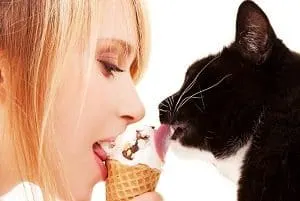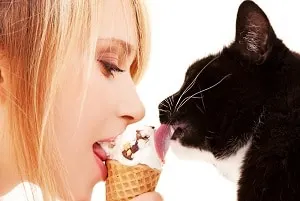 Your cat might be trained not to beg for human food, but you’ve probably noticed that your feline friend seems to perk up around your bowl of ice cream. Ice cream might seem like a strange choice for a carnivore, but once you’ve had a cat or two you’ll get used to this kind of begging. Your cat is probably also drawn to the smell of ice cream. The scent tells them there are plenty of delicious fats and carbohydrates in your bowl. Like any responsible pet owner, your first question is probably whether it’s safe to share your treat with your cat.
Your cat might be trained not to beg for human food, but you’ve probably noticed that your feline friend seems to perk up around your bowl of ice cream. Ice cream might seem like a strange choice for a carnivore, but once you’ve had a cat or two you’ll get used to this kind of begging. Your cat is probably also drawn to the smell of ice cream. The scent tells them there are plenty of delicious fats and carbohydrates in your bowl. Like any responsible pet owner, your first question is probably whether it’s safe to share your treat with your cat.
So, can cats eat chocolate ice cream? No, cats shouldn’t have chocolate ice cream. Some flavoring can be toxic to cats, and sugar isn’t very good for them either. Chocolate is harmful to cats due to caffeine and theobromine. Most cats are lactose intolerant making ice cream a bad choice for pets.
The good news is, even if you can’t share your ice cream with your pet, there are alternatives. We’ll talk a little more about why ice cream isn’t for cats, and then some fun alternatives you can give your cat as a treat (and toy).
Adult Cats And Lactose Intolerance
Adult cats have lactose intolerance, just like many people, and can’t drink milk without getting an upset stomach. While your cat usually won’t vomit because of milk (or ice cream) they might behave a little strangely or seem lethargic.
You’ll also probably notice a stinky surprise in the litterbox later. Ice cream and other dairy products can give your cat diarrhea. It’s just one of the many common cat health issues a cat owner has to face.
While your cat will usually feel better after a couple of hours and going to the bathroom, some cats do have a more severe reaction. They might have multiple episodes of diarrhea, and they might not always make it to the litter box.
If your cat seems to be having a severe reaction to ice cream or seems really out of sorts, it’s a good idea to get in touch with your vet.
Ice Cream Flavors
There is some good news here. Vanilla is perfectly safe for cats, and has been used as a flavoring in some cat treats! However, other varieties of ice cream flavoring probably aren’t safe.
Chocolate is toxic to cats, which is why chocolate ice cream is something your cat should not have. Most types of chocolate aren’t very tempting around felines, but you should be extra careful with a bowl of ice cream. Even licking an empty bowl can give your cat a toxic dose of chocolate.
Chocolate is especially damaging because it contains caffeine and theobromine. Theobromine absorbs differently in humans than in pets. For cats, it absorbs slowly which makes it toxic. The cat’s body cannot process it properly, and in large amounts can be detrimental to your cat’s health.
If you were to find your cat has eaten chocolate, chances are you’ll notice them vomiting or becoming increasingly restless due to an increased heart rate. You may find them dehydrated, experiencing nausea, fever, trouble breathing, and even having a seizure!
This study breaks down the various ingredients found in chocolate as well as toxicity.
Other flavors, from fruit flavors to caramel, should also be avoided. Even if the flavor itself isn’t toxic, there are plenty of other reasons to keep your ice cream away from your cat. Not least so that you can eat it yourself!
Sugar and Artificial Sweeteners
Sugar also isn’t particularly good for cats. In fact, felines can’t taste the sweetness in their food at all and aren’t designed to process sugar-dense foods.
Cats are obligate carnivores. That means that they are required to get a significant portion of their nutrition from meat.
Almost all cat food contains a combination of meats, grains, and some fruits and vegetables. But they aren’t sweetened. A lot of sugar burdens the cat’s digestive system, overloading it and causing negative health consequences.
Sugar is more of a risk for obese cats or cats that already have diabetes, for much the same reasons that sugar isn’t good for humans with those conditions. There are calories in the sugar, even though your cat can’t taste it, but it doesn’t provide nutrition.
Sugar is also calorie-dense, which makes it worse for cats since they don’t need nearly as many calories in the day as you do.
Cats Can’t Digest Artificial Sweeteners
Artificial sweeteners are another story entirely. Your cat can digest sugar, but they aren’t very likely to be able to digest artificial sweeteners. Unfortunately, a lot of artificial sweeteners can also be toxic to cats, especially if they get more than a lick or two.
If you suspect that your cat has eaten some ice cream made with artificial sweeteners, you should immediately call a vet. If your vet is closed, call the nearest animal hospital instead. You should also grab the box so that the vet knows what artificial sweetener your cat got into since each one needs to be addressed differently.
You should also know that more ice cream and other sweets are starting to be made with a combination of natural sugars and artificial sweeteners. If your cat got into your ice cream accidentally, read the ingredients list on your sugar just to be safe.
After visiting the vet, it’s important to feed your cat a simple diet to help them readjust. Get away from the treats for a while and of course, don’t allow them to get anywhere near chocolate ice cream again!
Cats Can Get Brain Freeze
There are lots of videos out there of cats eating some cold food, often ice cream, and making a funny face when they get an obvious brain freeze. The videos are cute, but you shouldn’t try to replicate them.
Think about the last time you had a brain freeze. It wasn’t comfortable, right? Cats experience a brain freeze similarly. It causes blood flow to the brain to constrict, leading to that momentary intense pain most of us remember from childhood.
The truth is, no amount of cuteness is worth causing your feline companion unnecessary pain.
That’s especially true since there aren’t any good ways for us to evaluate how much discomfort a brain freeze actually causes your cat. They might experience a similar kind of discomfort, or it might be a more intense feeling that they just can’t communicate.
Cat-Friendly Alternatives to Ice Cream:
There are several things you can do as an alternative to ice cream, that still gives your cat a treat and some additional stimulation.
Cat-Specific Ice Cream
Once a rare specialty item, cat ice cream, and frozen treats are getting increasingly common. Some are made to mimic the look of vanilla ice cream, including some mild vanilla taste, while still meeting your cat’s nutritional requirements. Others are flavored like fish, chicken, and other cat-friendly foods.
Getting ice cream look-alikes can be a good way to help your cat feel included in family summer treats, but it might not be a good idea if you aren’t good about putting your dirty ice cream bowls away.
Other flavors add variety and interest to your cat’s diet. Though, you should be prepared for the occasional rejection. Cats can be picky about what they eat, so your feline friend might not always be tempted by the latest treats.
Always serve in small portions, and it’s okay if your cat’s cool treat isn’t truly frozen. After all, you don’t want to give them a brain freeze.
Feed Your Cat Ice Cubes
Many cats are absolutely fascinated by plain old ice cubes, no flavoring needed. The temperature difference is stimulating and gives them something to concentrate on, or even play with. Plus, licking at an ice cube can encourage good hydration.
This is one treat you can give your cat every day if you want to.
Add a couple of ice cubes to your cat’s normal water dish. If that seems boring, consider freezing a larger ice cube using a plastic glass or a small pan as a mold. Putting the ice on a plate or in a baking pan can reduce the mess, but don’t be surprised if your cat manages to pry some ice free anyway.
Frozen or Chilled Wet Food
Another way to give your cat a stimulating treat is to use their regular wet food. If their food is particularly wet, you can freeze it as is. Pate wet foods can also have a little water added so that they can be mushed into a paste and then frozen in a mold.
Don’t add milk to your cat’s food to water it down, even if they like it. As we’ve already mentioned, cats are generally lactose intolerant and won’t do well with milk in their diet.
If you must add milk, look for cat milk (which is either lactose-free or contains added lactase enzyme), or purchase low-fat, low-sugar milk like goats’ milk from a specialty pet store. Even with those kinds of milk, limit your cat’s intake to a small amount, and only occasionally.
Other Options For Your Cat
Other ice cream alternatives include:
- Frozen, unseasoned bone broth
- Ice cubes with suspended kibble or cat treats
- Ice cubes with cat-nip
At the end of the day, no matter what treats you’re offering your cat, remember that they should be treats. These foods aren’t a substitute for good cat food and should be a very small part of your cat’s overall diet.
You can enjoy your ice cream, but give your cats something just for them!

My name is James, and welcome to FAQCats!
Along with our team of cat owners, expert pet enthusiasts, and pet professionals, we aim to write engaging helpful, engaging content about cats. At FAQCats we strive to provide content that’s accurate and fun to read. Our team writes about everything related to cats; even the most complex of topics. Through extensive research and caring for our own fur-pals, we’re able to provide something cat owners worldwide will love. Have a look around, and leave us feedback anytime!

